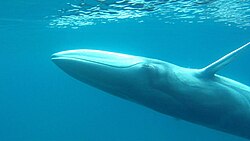Omura's whale
| Omura's whale | |
|---|---|
 |
|
| Omura's whale | |
| Scientific classification | |
| Kingdom: | Animalia |
| Phylum: | Chordata |
| Class: | Mammalia |
| Order: | Artiodactyla |
| Infraorder: | Cetacea |
| Family: | Balaenopteridae |
| Genus: | Balaenoptera |
| Species: | B. omurai |
| Binomial name | |
|
Balaenoptera omurai Wada et al., 2003 |
|
Omura's whale or the dwarf fin whale (Balaenoptera omurai) is a species of rorqual about which very little is known. Before its formal description, it was referred to as a small, "dwarf" or "pygmy" form of Bryde's whale by various sources. The common name and specific epithet commemorate Japanese cetologist .
The scientific description of this whale was made in Nature in 2003 by three Japanese scientists. They determined the existence of the species by analysing the morphology and of nine individuals – eight caught by Japanese research vessels in the late 1970s in the Indo-Pacific and an adult female collected in 1998 from Tsunoshima, an island in the Sea of Japan. Later, abundant genetic evidence confirmed Omura's whale as a valid species and revealed it to be an early offshoot from the rorqual lineage, diverging much earlier than Bryde's and sei whales. It is perhaps more closely related to its larger relative, the blue whale.
In the third edition of Mammal Species of the World, the "species" is relegated to being a synonym of Balaenoptera edeni. However, the authors note that this is subject to a revision of the genus. The database ITIS lists this as a valid taxon, noting a caveat on the disputed systematics of this species, Balaenoptera edeni and Balaenoptera brydei.
The six specimens obtained in the Solomon Sea in 1976 were only noted to be smaller at sexual maturity than the "ordinary" Bryde's whales caught off New Zealand, whereas the two caught near the Cocos-Keeling Islands in 1978 were not differentiated from the 118 other "ordinary" Bryde's whales taken in the eastern Indian Ocean, south of Java. As a result of allozyme analysis, their distinctive baleen and small size at physical maturity compared to Bryde's whale, and photographs obtained of the harvested whales (showing their fin whale-like coloration), Dr. Shiro Wada and Kenichi Numachi (1991) decided that these eight individuals represented members of a new species of baleen whale. However, due to the lack of a detailed osteological study and the absence of "conclusive data", the International Whaling Commission decided to consider them only as a regionally distinct group of "small-form Bryde's whale". Despite this declaration, the specific status of the Solomon Sea specimens was supported by a mitochondrial DNA study done by Hideyoshi Yoshida and Hidehiro Kato (1999).
...
Wikipedia

